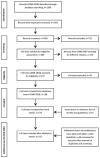Talking about the end of life: communication patterns in amyotrophic lateral sclerosis - a scoping review
- PMID: 35309870
- PMCID: PMC8928370
- DOI: 10.1177/26323524221083676
Talking about the end of life: communication patterns in amyotrophic lateral sclerosis - a scoping review
Abstract
Amyotrophic lateral sclerosis (ALS) leads to death on average 2-4 years after the onset of symptoms. Although many people with the disease decide in favour of life-sustaining measures, some consider hastening death. The objectives of this review are to provide an insight into the following questions: (1) How do people with amyotrophic lateral sclerosis (PALS), their families and health care professionals (HCPs) communicate about life-sustaining and life-shortening options? (2) What are the challenges for all involved in decision making and communication about this topic? To answer these questions, we searched eight databases for publications in English and German on end-of-life issues of PALS. We included texts published between 2008 and 2018, and updated our search to May 2020. Sources were analysed in MAXQDA using deductively and inductively generated codes. After the final analysis, 123 full texts were included in this review. We identified a wide range of communicative challenges and six different and, in part, opposite communication patterns: avoiding or delaying communication on end-of-life issues, openly considering dying and actively seeking assistance, ignoring or disregarding patients' wishes, discussing and respecting the patients' wishes, engaging in advance care planning and avoiding or delaying advance care planning. The literature reveals a very heterogeneous response to end-of-life issues in ALS, despite several good-practice suggestions, examples and guidelines. We derive a strong need for harmonization and quality assurance concerning communication with PALS. Avoiding or delaying communication, decision making and planning, as well as ignoring or disregarding the patient's will by HCP can be judged as a violation of the ethical principles of autonomy and non-maleficence.
Keywords: advance care planning; assisted suicide; communication strategies; end-of-life decision making; euthanasia; wish to hasten death.
© The Author(s), 2022.
Conflict of interest statement
Conflict of interest statement: The authors declared no potential conflicts of interest with respect to the research, authorship, and/or publication of this article.
References
-
- EFNS Task Force on Diagnosis and Management of Amyotrophic Lateral Sclerosis,Andersen PM, Abrahams S, et al.. EFNS guidelines on the clinical management of amyotrophic lateral sclerosis (MALS) – revised report of an EFNS task force. Eur J Neurol 2012; 19: 360–375. - PubMed
-
- Seitzer F, Kahrass H, Neitzke G, et al.. The full spectrum of ethical issues in the care of patients with ALS: a systematic qualitative review. J Neurol 2016; 263: 201–209. - PubMed
-
- Motor Neurone Disease Association (MNDA). Motor neurone disease: a guide for GPs and primary care teams. Northampton: Motor Neurone Disease Association, 2018.
-
- National Clinical Guideline Centre. Motor neurone disease: assessment and management. NICE guideline NG42: methods, evidence and recommendations. London: National Institute for Health and Care Excellence; (Great Britain), 2016. - PubMed
-
- Motor Neurone Disease Association (MNDA). A professionals guide to end of life care in motor neurone disease. Northampton: Motor Neurone Disease Association, 2019.
Publication types
LinkOut - more resources
Full Text Sources
Miscellaneous


